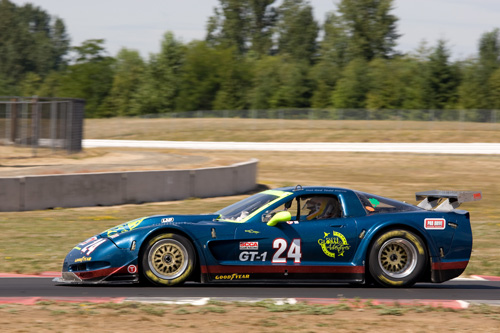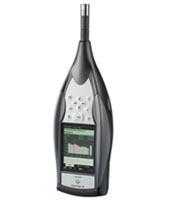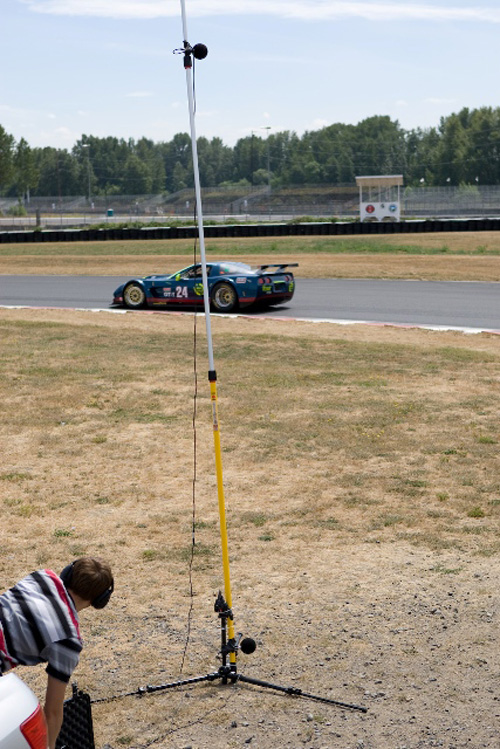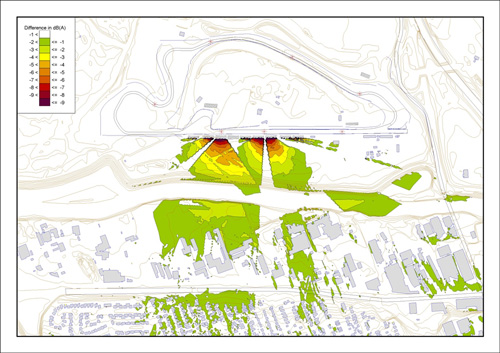Acoustical Society of America
157th Meeting Lay Language Papers
Prediction of Noise from the Portland International Raceway
Prediction of Noise from the Portland International Raceway
Angus Deuchars - angus.deuchars@arup.com
Arup Acoustics
San Francisco, CA
Popular version of paper 5aNS2
Presented Friday morning, May 22, 2009
157th ASA Meeting, Portland, OR
Portland International Raceway (PIR) is an existing motor vehicle racing facility located within the metropolitan area of Portland, Oregon. A master plan for PIR is currently being developed that will rejuvenate the facility, and a key concept of the master plan is reducing noise levels from the raceway in nearby residential communities.
![]()
Figure 1. Aerial photograph of Portland International Raceway
The master plan includes constructing new structures such as spectator grandstands, workshops, offices, and retail. The intention is to make use of the new structures as noise barriers to reduce raceway noise levels in the adjacent neighborhoods.
Figure 2. Rendering of the proposed master-plan for Portland International Raceway
Coordinating the optimum locations around the raceway for these new structures is being aided through the use of environmental noise computer modeling techniques. Computer modeling allows making rapid and accurate noise simulations of master plan concepts and the evaluation of options for the optimum locations for the new structures.
Environmental noise models are typically used to calculate the noise levels at noise sensitive receptors from a known source of environmental noise, such as a highway. The models apply standardized national or international calculation methodologies, and are typically constructed for urban planning projects such as determining noise levels from a proposed highway alignment at a nearby residential community. The methodologies include noise source-specific sound propagation equations and reference noise source level data for different sources of environmental noise, such as vehicular highways, railways, and aircraft.
The noise model for PIR was unique because none of the national or international environmental noise calculation methodologies were directly applicable. To accurately predict noise from the raceway, it was necessary to combine the methodologies of two international environmental noise standards.
The first was used to calculate the reduction in noise from noise sources (raceway cars) to noise sensitive receivers (residences). The reduction in noise is due to propagation factors such as ground absorption, reduction from intervening structures (noise barriers, buildings, ground contours), and reduction due to distance. The second methodology was used to quantify the measurement approach for establishing the source noise levels.
The innovative part to this study was the combination of these two prediction methodologies for accurate predictions of noise from motor racing vehicles.
At the raceway noise measurements were made at the racetrack edge of a race vehicle following the prescribed measurement methodology. Concurrently, noise measurements were also made at specific locations around the facility to determine the propagation noise attenuation from the racetrack edge to these locations (more on this later).

Figure 3. Noise measurements were made of this motor racing vehicle
The measurements were made using high precision sound level meters. Modern sound level meters are handheld computers that consist of a precision microphone, which captures the noise, and a computer, which processes the noise, displays the level in decibels on a display, and saves it in a file for later analysis.

Figure 4. Handheld inegrated sound level meter
The methodology required that measurements be made within 15m of the motor racing vehicle, and two simultaneous noise measurements be made using a vertical spacing for the microphones of 0.2m and 4m above the ground. To meet the vertical sound level meter spacing requirements of the noise measurement methodology, it was necessary to construct a custom boom assembly.

Figure 5. Custom noise measurement boom assembly
The typical measured noise level of the motor racing vehicle was 105 dB(A). This level is very high, and is equivalent to being inside a night club, or next to a jackhammer or chainsaw.
Calibrated audio recordings of the motor vehicle pass-by measurements were also made. Audio recordings were made to provide a backup in the event that the digital noise measurement files became corrupted. The noise levels could be obtained from the audio files using advanced computer signal processing techniques if necessary.
Comments were made by frequent users of the racetrack that noise seems to reverberate (multiple echoes) around the facility. This was an interesting comment, because if multiple noise reflections of structures around the facility were occurring, these noise reflections could adversely affect the measurement data.
To verify these comments impulse response measurements were made using a starter’s pistol as the impulsive noise source. Impulse response measurements are the acoustic blueprints of the measurement location and show the timing sequence of the arrivals of acoustic energy.
For PIR the time sequence begins with the arrival of the direct sound from the starter’s pistol and continues with the subsequent arrivals of sound which has been reflected off nearby surfaces. By looking at the arrival time of the direct sound and the various reflections the presence or lack of echoes could be established.
 |
| Figure 6. The author (having only ever discharged a firearm once, and literally once before) carrying out an impulse response measurement |
The computer model was constructed by importing 3-D topographical maps of the study area into specialist environmental noise computer modeling software. Topographical maps typically contain ground elevation contour heights and building locations. Information pertinent to the computer model is extracted from the topographical maps; this forms the 3-D digital geometry of the computer model.
 |
| Figure 7. Rendering of Portland International Raceway environmental noise computer model geometry |
A computer model of the existing PIR site was constructed to determine the accuracy of noise predictions. The accuracy of predictions was verified by comparing noise predictions made using the computer model to noise measurements made at the same location. This step is necessary to verify the noise predictions and provide greater confidence in the results.
The predictions made with the computer model are considered validated provided the difference between measured and predicted noise levels is within a tolerance of ±3 dB. A tolerance of ±3 dB is used because 3 dB is the smallest discernible audible change in noise level humans can detect.
Noise predictions of the existing PIR site made using the computer model were within the tolerance of ±3 dB when compared to measured noise levels; some were within ±1 dB. The results were very encouraging and based on the ±3 dB tolerance being achieved, the computer model noise predictions were considered validated.
The computer model is now being used to advise PIR on optimum locations for structures around the facility. The results from an early noise model simulation are shown in Figure 8. The results show the reduction in noise which occurs when the rear of spectator grandstands situated along the finishing straightaway are made solid rather than left open as typically done.
 |
| Figure 8. Rendering showing noise reduction from making rear of spectator grandstands along finishing straight solid |
The predicted results indicate maximum noise reduction in close proximity to the spectator grandstands and less noise reduction with increased distance from the grandstands. This is shown graphically by the red color rendering close to the track and green rendering in the residential community.
Noise reduction by the grandstands follows basic theory for noise barriers. In close proximity to the barrier, where line of sight to the noise source is the most obscured, maximum noise reduction occurs. As the receptor point moves away from the barrier, the source starts to become visible, and noise reduction decreases.
The results indicated that making the rear of the grandstands solid would result in a reduction of 1 dB in the nearby residential community. The predicted reduction in noise is not considered to be significant because the smallest discernible audible change in noise level humans can detect is
3 dB.
The noise model that has been developed for PIR will help facilitate the noise reduction concept of the master plan, and also help demonstrate that PIR is committed to working with local communities at reducing noise exposure from the raceway.